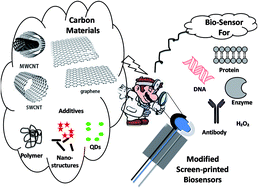Recent build outs in electroanalytical biosensors based on carbon-nanomaterial modified screen printed electrode platforms
Abstract
The incorporation of carbon-based nanomaterials, such as carbon nanotubes and graphene, as a modifier for the working electrode in the field of electroanalytical sensing has increased considerably nowadays due to their unique properties and, very importantly, due to the ease of functionalization of these materials. With the aggravating demand for decentralized sensing, traditional techniques requiring expensive, immovable analytical equipment, such as gas chromatography and mass spectrometry, are not always feasible for use. The screen printing technology has overtaken the traditional techniques in analyzing biological and environmental samples where immediate on-site monitoring is required. Screen printed electrodes (SPEs) are the miniaturized form of sensors which have many desirable properties like low power consumption, reduced weight, low costs, possible large-scale production, immediate on-site monitoring of real samples and reusability, which makes them a suitable platform for commercialization. The earlier screen printed electrodes used carbon inks which gave a weak signal output. So, to cut down the flaws of the signal output, the carbon inks of screen printed electrodes have been replaced by these carbon nanomaterials. Here, in this review we have tried to provide an insight into the recent advancements in the biosensor technology based on carbon nanomaterial-modified screen printed electrodes.


 Please wait while we load your content...
Please wait while we load your content...